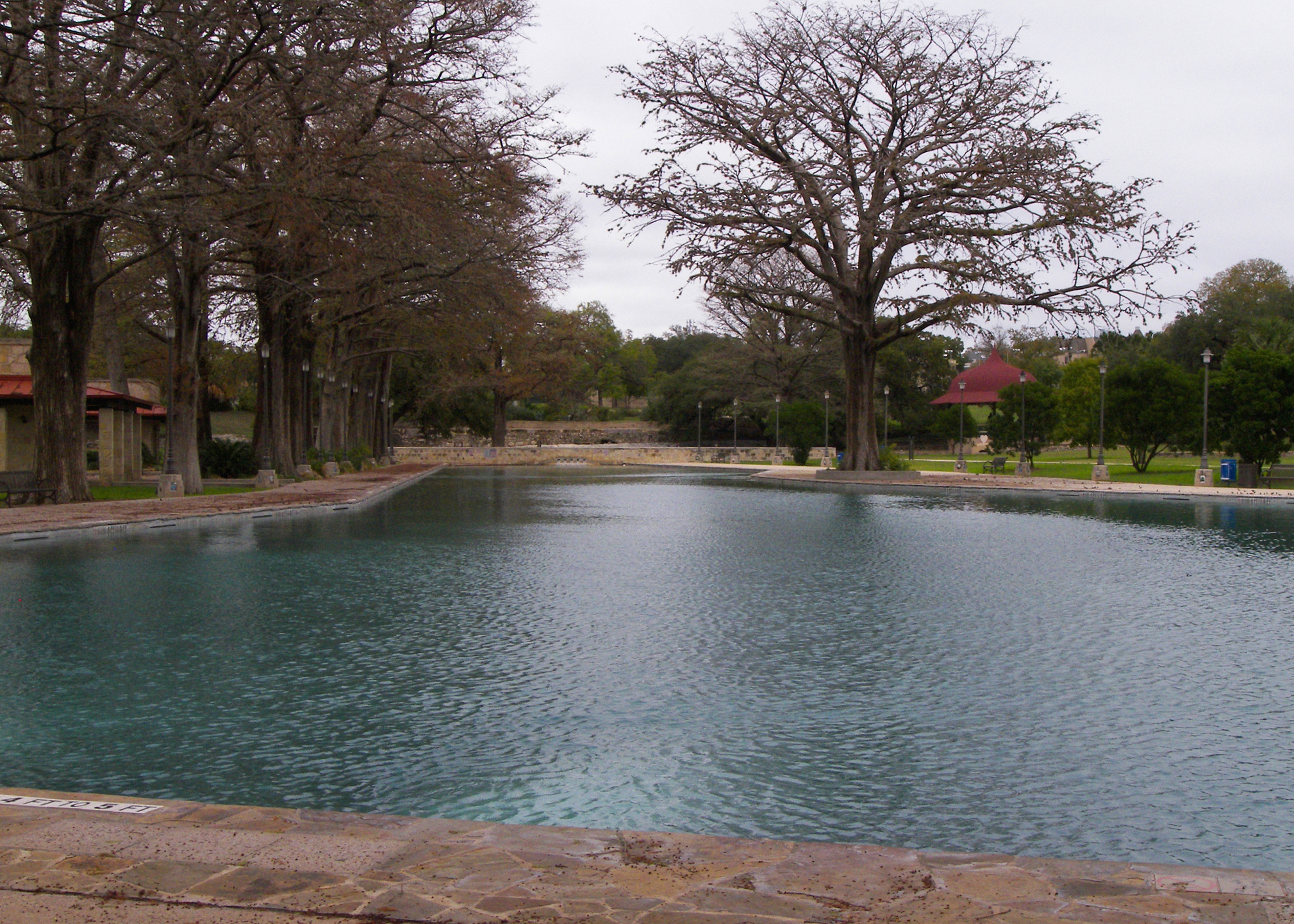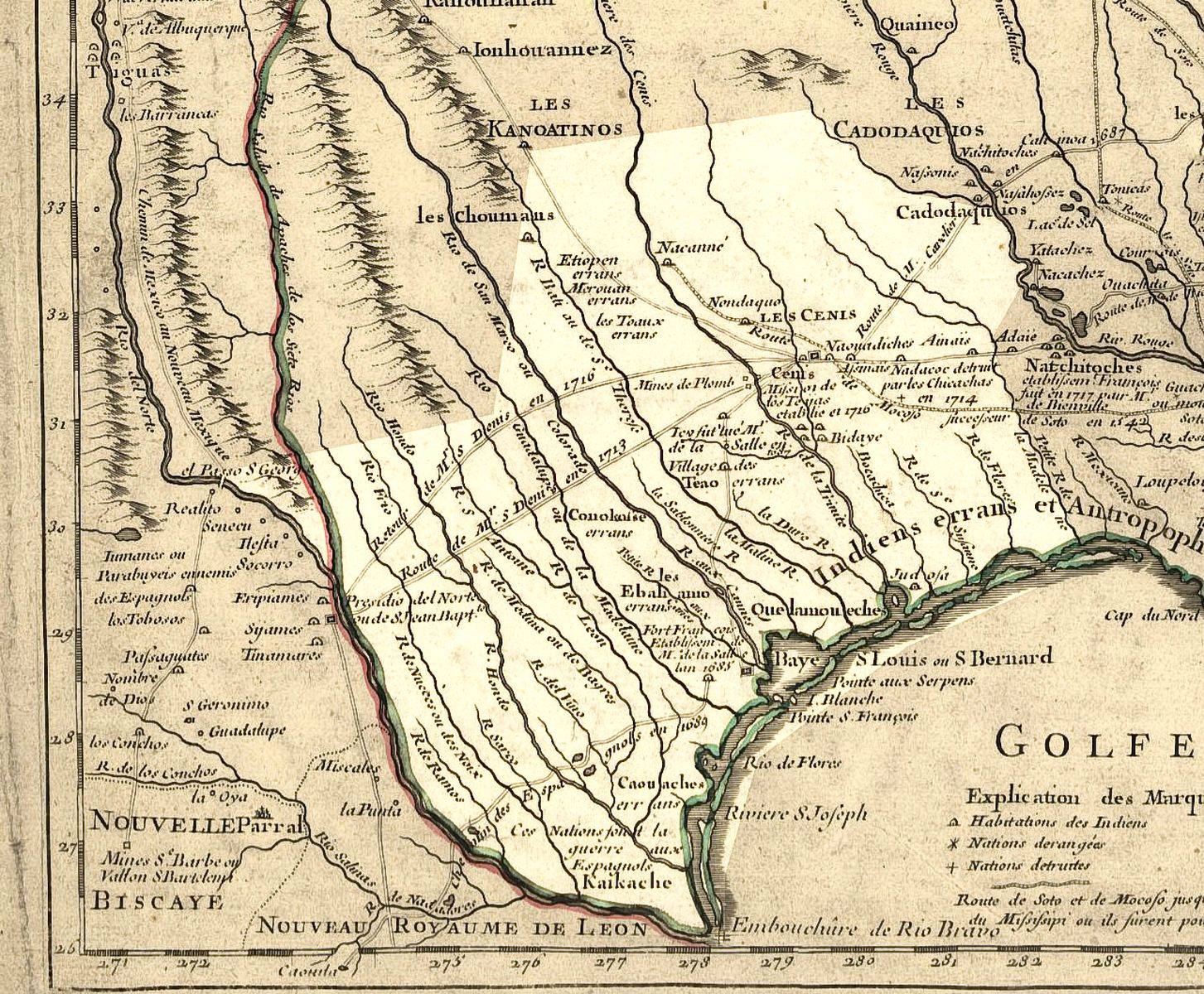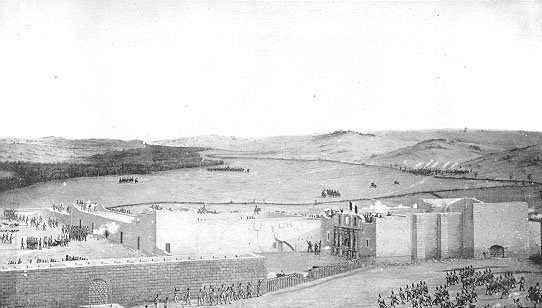|
Yanaguana (San Antonio)
Yanaguana was the Payaya people village in the geographical area that became the Bexar County city of San Antonio, in the U.S. state of Texas. Some accounts believe the Payaya also referred to the San Antonio River as Yanaguana, and it is sometimes promoted as such for the tourist industry. For a number of years, the city of San Antonio contracted with Yanaguana Cruises Inc. for an exclusive monopoly to operate tour barges on a select section of the river. The National Park Service has a designated "Yanaguana Trail" that runs along the river at Mission San Juan Capistrano. In 1933 Frederick C. Chabot of San Antonio formed the Yanaguana Society, specifically named for the Payaya village, to collect and preserve the early artifacts and history of the area. The organization lasted through 1960. The first recorded European contact with the village occurred when Spanish Franciscian priest Damián Massanet led a military expedition through the area. Massanet wrote in the June 13, 169 ... [...More Info...] [...Related Items...] OR: [Wikipedia] [Google] [Baidu] |
Martín De Alarcón
Martín de Alarcón was the Governor of Coahuila and Spanish Texas from 1705 until 1708, and again from 1716 until 1719. He founded San Antonio, the first Spanish civilian settlement in Texas. Texas First term Alarcón was first appointed governor of the Spanish provinces of Coahuila and Texas in 1705.Weddle (1967), p. 548. At this time, no Spanish settlements existed in Texas. The last of the original Catholic missions in East Texas had been abandoned in 1699. The French had been establishing settlements west of the Mississippi River, and Spanish authorities feared that the French would expand into Texas. In 1707, the viceroy of New Spain ordered all provincial governors to prevent the entry of foreigners and their goods.Chipman (1992), p. 107. Alarcón proposed that one of the missions along the Rio Grande, Mission San Bernardo, be relocated into Texas, along the Frio River. Nothing came of this idea, and later in 1707 Alarcón authorized an expedition into Texas, prima ... [...More Info...] [...Related Items...] OR: [Wikipedia] [Google] [Baidu] |
History Of San Antonio
The City of San Antonio is one of the oldest Spanish settlements in Texas and was, for decades, its largest city. Before Spanish colonization, the site was occupied for thousands of years by varying cultures of indigenous peoples. The historic Payaya Indians were likely those who encountered the first Europeans. The "Villa de Bejar" was founded by Spanish explorers on May 5, 1718, by then Governor Martin Alarcon, at the headwaters of the San Pedro Creek. The mission San Antonio de Valero was established on the east bank of the creek and a presidio was 3/4 of a league downstream. Development of the Spanish colonial city followed. A trading post was also established near the presidio and the town developed as the capital of Tejas, a province of colonial Spain. It was the northernmost settlement associated with the Hispanic culture of the Valley of Mexico. After Mexico achieved independence in 1821, Anglo-American settlers entered the region from the United States. In 1836, Anglo- ... [...More Info...] [...Related Items...] OR: [Wikipedia] [Google] [Baidu] |
Acequia Madre De Valero (San Antonio)
Acequia Madre de Valero is an 18th-century agricultural irrigation canal built by the Spanish and located in the Bexar County city of San Antonio in the U.S. state of Texas. When Martín de Alarcón founded San Antonio for Spain by establishing San Antonio de Valero Mission in 1718, Franciscan priest Antonio de Olivares and the Payaya and Pastia peoples, dug Acequia Madre de Valero by hand. It was vital to the missions to be able to divert and control water from the San Antonio River, in order to grow crops and to supply water to the people in the area. This particular acequia was the beginning of a much wider irrigation system. Acequia Madre de Valero ran from the area currently known as Brackenridge Park southward to what is now Hemisfair Plaza and South Alamo Street. Part of it that is not viewable by the public runs beneath the Menger Hotel. The acequia was restored in 1968 and that same year was designated a Recorded Texas Historic Landmark. Acequia Madre de Valero was t ... [...More Info...] [...Related Items...] OR: [Wikipedia] [Google] [Baidu] |
Philip V Of Spain
Philip V ( es, Felipe; 19 December 1683 – 9 July 1746) was King of Spain from 1 November 1700 to 14 January 1724, and again from 6 September 1724 to his death in 1746. His total reign of 45 years is the longest in the history of the Spanish monarchy. Philip instigated many important reforms in Spain, most especially the centralization of power of the monarchy and the suppression of regional privileges, via the Nueva Planta decrees, and restructuring of the administration of the Spanish Empire on the Iberian peninsula and its overseas regions. Philip was born into the French royal family (as Philippe, Duke of Anjou) during the reign of his grandfather, King Louis XIV. He was the second son of Louis, Grand Dauphin, and was third in line to the French throne after his father and his elder brother, Louis, Duke of Burgundy. Philip was not expected to become a monarch, but his great-uncle Charles II of Spain was childless. Philip's father had a strong claim to the Spanish throne, bu ... [...More Info...] [...Related Items...] OR: [Wikipedia] [Google] [Baidu] |
Antonio De Olivares
Antonio de San Buenaventura y Olivares or simply Fray Antonio de Olivares (1630 - 1722) was a Spanish Franciscan who officiated at the first Catholic Mass celebrated in Texas, and he was known for contributing to the founding of San Antonio and to the prior exploration of the area. He founded, among other missions, the Alamo Mission in San Antonio (better known as simply the Alamo), the Presidio San Antonio de Bexar, and the Acequia Madre de Valero. Biography Early career Antonio de San Buenaventura y Olivares was born in Moguer, Andalusia, Spain, in 1630 and studied at the Franciscan convent of San Francisco de Moguer. In 1665, at the age of thirty-five years old, he went on a religious expedition to the Americas, along with 19 other religious. Once in Americas, in the Convent of Querétaro, he received the training he needed to engage with the natives, in their work of evangelization. It was this monastery from which they went on various expeditions in Texas, since this w ... [...More Info...] [...Related Items...] OR: [Wikipedia] [Google] [Baidu] |
San Antonio River
The San Antonio River is a major waterway that originates in central Texas in a cluster of springs in midtown San Antonio, about 4 miles north of downtown, and follows a roughly southeastern path through the state. It eventually feeds into the Guadalupe River (Texas), Guadalupe River about 10 miles from San Antonio Bay on the Gulf of Mexico. The river is 240 miles long and crosses five counties: Bexar County, Texas, Bexar, Goliad County, Texas, Goliad, Karnes County, Texas, Karnes, Refugio County, Texas, Refugio, and Wilson County, Texas, Wilson. History Naming the river The first documented record of the river was from Álvar Núñez Cabeza de Vaca on his explorations of Texas in 1535. The river was later named after Anthony of Padua, San Antonio de Padua by the first governor of Spanish Texas, Domingo Terán de los Ríos in 1691. On June 13, 1691, Governor Terán and his company camped at a rancheria on a stream called Yanaguana (San Antonio), Yanaguana They renamed the s ... [...More Info...] [...Related Items...] OR: [Wikipedia] [Google] [Baidu] |
Presidio San Antonio De Bexar
A presidio ( en, jail, fortification) was a fortified base established by the Spanish Empire around between 16th and 18th centuries in areas in condition of their control or influence. The presidios of Spanish Philippines in particular, were centers where the martial art of Arnis de Mano was developed from Spanish cut-and-thrust fencing style. The term is derived from the Latin word ''praesidium'' meaning ''protection'' or ''defense''. In the Mediterranean and the Philippines, the presidios were outposts of Christian defense against Islamic raids. In the Americas, the fortresses were built to protect against raid of pirates, rival colonists, as well as Native Americans. Later in western North America, with independence, the Mexicans garrisoned the Spanish presidios on the northern frontier and followed the same pattern in unsettled frontier regions such as the Presidio de Sonoma, at Sonoma, California, and the Presidio de Calabasas, in Arizona. In western North America, a '' ... [...More Info...] [...Related Items...] OR: [Wikipedia] [Google] [Baidu] |
Alamo Mission In San Antonio
The Battle of the Alamo (February 23 – March 6, 1836) was a pivotal event in the Texas Revolution. Following a 13-day siege, Mexican troops under President General Antonio López de Santa Anna reclaimed the Alamo Mission near San Antonio de Béxar (modern-day San Antonio, Texas, United States), killing most of the occupants inside. Santa Anna's refusal to take prisoners during the battle inspired many Texians and Tejanos to join the Texian Army. Motivated by a desire for revenge, as well as their written desire to preserve a border open to immigration and the importation and practice of slavery, the Texians defeated the Mexican Army at the Battle of San Jacinto, on April 21, 1836, ending the rebellion in favor of the newly formed Republic of Texas. Several months previously, Texians, who were primarily recent immigrants from USA, had killed or driven all Mexican troops out of Mexican Texas. About 100 Texians were then garrisoned at the Alamo. The Texian force grew s ... [...More Info...] [...Related Items...] OR: [Wikipedia] [Google] [Baidu] |
San Pedro Springs Park
San Pedro Springs Park is located in the Bexar County city of San Antonio in the U.S. state of Texas. Surrounding the source of the springs, the 46-acre park is the oldest in the state of Texas. It is the location of a Payaya Indian village known as Yanaguana, and is the original site of the city of San Antonio. The park is alternately known as San Pedro Park. The park was designated a Recorded Texas Historic Landmark in 1965. It was added to the National Register of Historic Places listings in Bexar County, Texas on November 1, 1979. Although it is often stated that it is the second oldest city park in the United States after Boston Common, it is at most the tenth oldest after Plaza de la Constitución in San Augustine, Florida among others. History, first European contact, founding of San Antonio Archaeological findings have uncovered evidence that human presence in the area dates back 12,000 years. The earliest recorded inhabitants of the springs were the Payaya people, who ... [...More Info...] [...Related Items...] OR: [Wikipedia] [Google] [Baidu] |
Payaya People
The Payaya people were Indigenous people whose territory encompassed the area of present-day San Antonio, Texas. The Payaya were a Coahuiltecan band and are the earliest recorded inhabitants of San Pedro Springs Park, the geographical area that became San Antonio. History The band are known to have inhabited the areas of the San Antonio River, the Frio River to the west, near the Pastia tribal lands; and Milam County to the east, where they lived among the Tonkawa. The Payaya called their village Yanaguana. It was located next to the river which the Spanish named the San Antonio. Some historians believe the band referred to the river as Yanaguana, but the Spanish Franciscan priest Damián Massanet recorded this as the name of their village. The Payaya first made contact with Spanish colonists in the 17th century, when the tribe had ten different encampments. By the year 1706, the Spanish had converted some Payaya among the Indigenous converts baptized at Mission San Fra ... [...More Info...] [...Related Items...] OR: [Wikipedia] [Google] [Baidu] |
Isidro De Espinosa
Isidro Félix de Espinosa (1679–1755) was a Franciscan missionary from New Spain who participated in several expeditionary missions throughout the province of Tejas (modern Texas). He was the president of the missionaries from the College of Santa Cruz de Querétaro. Early life Espinosa was born in the Spanish American area of Querétaro in modern-day Mexico. He was the son of Isidro de Espinosa and Gertrudis de Miraelrío Tovar. Espinosa had nine siblings, although three of them did not make it to adulthood. On March 18, 1696, Espinosa started studying at the College of Santa Cruz de Querétaro, and on March 19, 1697, began his career as a Franciscan. On December 17, 1703, he received holy orders and on February 26 of that year he became a priest. Sometime between the end of 1703 and early 1704 he joined the Mission San Juan Bautista. Missionary work On April 5, 1709, an expeditionary group made up of Father Espinosa and Father Antonio de Olivares, along with Captain P ... [...More Info...] [...Related Items...] OR: [Wikipedia] [Google] [Baidu] |






